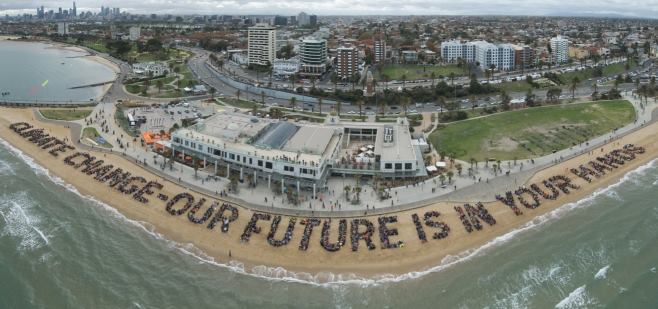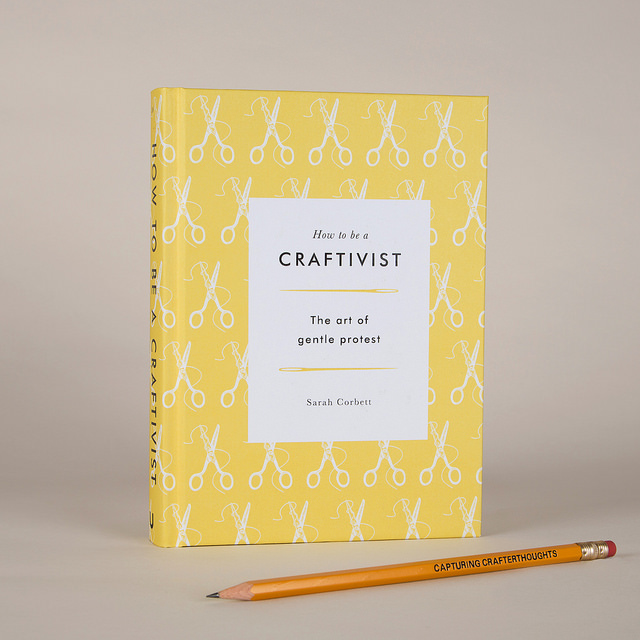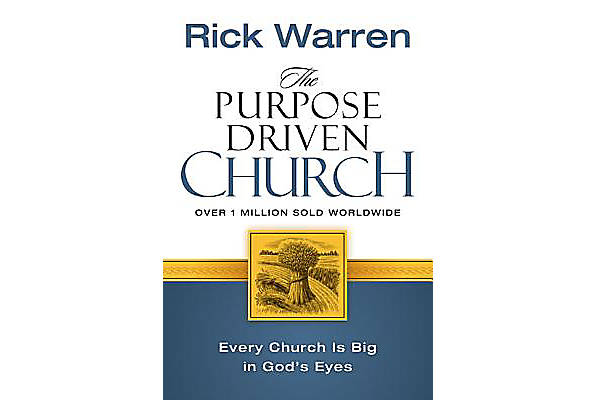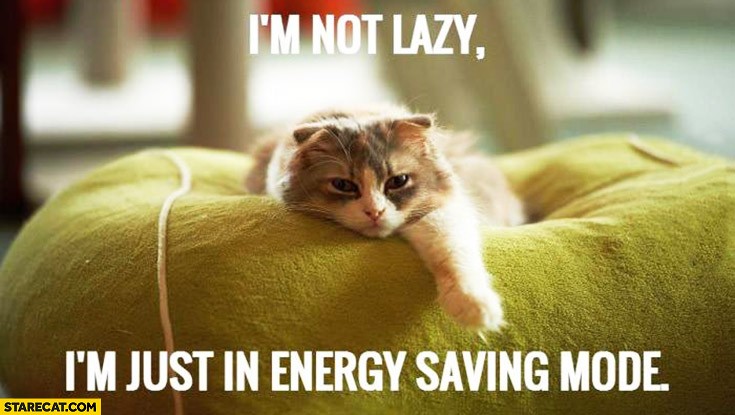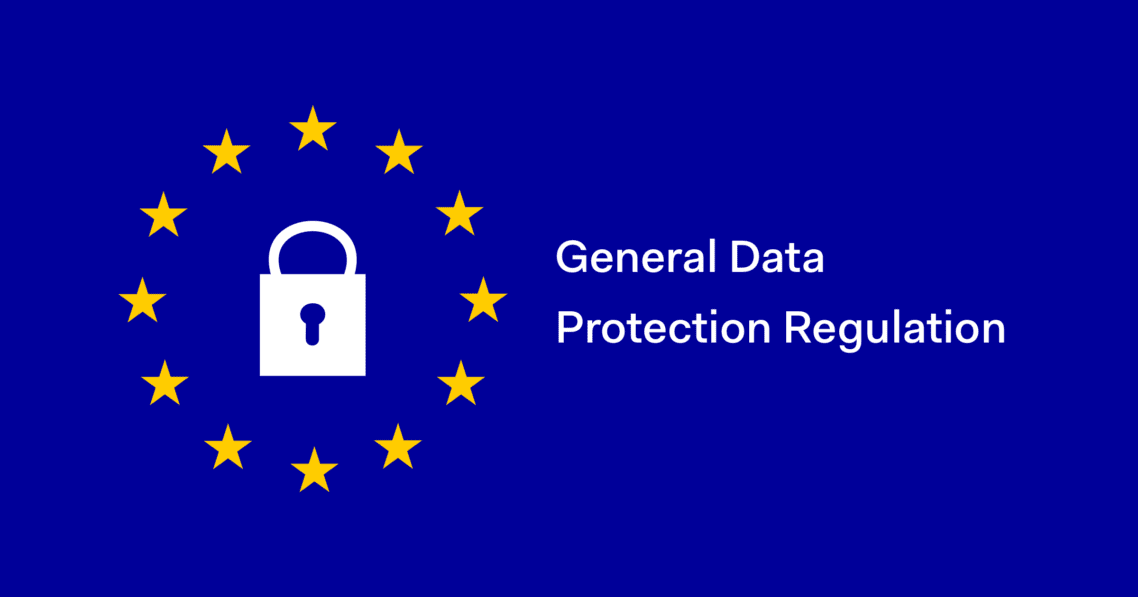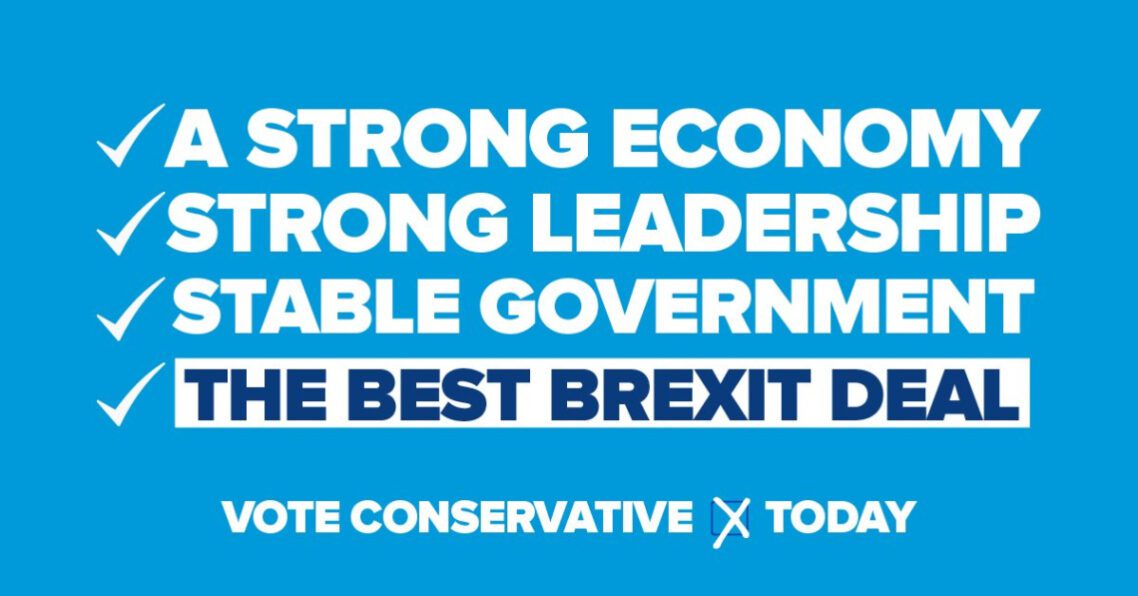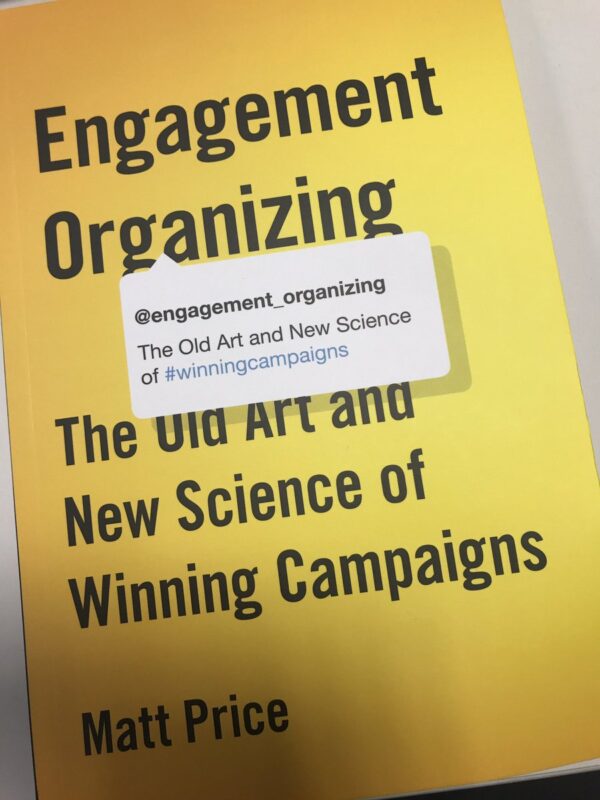After the last few years we’ve had, it seems foolish to make any predictions about what might happen in 2018. So as we start a new year for campaigning, I’ve decided not to make some predictions, but as I head back to work for the new yearm to make some suggestions of conversations that I hope we can have to make us more effective campaigners in the next 12 months.
1 – Are the tactics we’re using working? The end of the email your MP actions have long been predicted, with MPs repeatedly telling us that they don’ find them effective, and others using software to filter them out before they land in their inboxes. As the Social Change Agency have written recently ‘digital campaigning can feel a little stale’, while organisations like 38 Degrees are also looking to overhaul their tools that let you contact your MP. But as a few innovate out of the problem, the declining impact of these approaches impacts us all so I hope we can have a conversation about how we use digital tools to maximise their impact.
2 – Ask each other why aren’t we winning – Call me old-fashioned, but for me campaigning is about winning change. It means that I can get frustrated when I get a request to join a campaign where I can’t see how my action will contribute to the desired change. At the heart of good campaigning is a clear theory of change, which has had the assumptions challenged and stretched before a path of action is reached. With limited resources, we need robust theories of change to win, so in 2018 I hope we can go back to resources like Pathways for Change to make sure we’re asking difficult questions when we’re not winning.
3 – What does the changing media landscape mean for our campaigning? Nine of the top 20 news articles shared during the election were from non-traditional outlets, while a story on animal sentience became the most viral politics article of 2017, and was started on a small agricultural news website. More and more people are getting their news from hyper partisan sites, with content designed to be shared on social media, and with Facebook. If campaigning is about shaping a news agenda, how do we do that in what feels like an increasingly polarised and fragmented media landscape?
4 – Can we do more to share what’s working? I was really excited to see 38 Degrees publish a comprehensive study into their turnout campaigning they’d done around the General Election, and Engaging Networks have shared some useful benchmarks, and this is great by Forward Action. All examples of people sharing what’s working without needing to. But it feels like there is so much we could be doing, and in a more comprehensive way. I’m a member of the US based Analyst Institute which looks to share academic and practioner studies about what’s working, but that’s very focused on American electoral politics. So how do we encourage more of this among campaigners, including making our evaluations, including the not so good parts, more accessible and available to others?
5 – How to take GDPR seriously, but not become overwhelmed by it – As I wrote back in the summer, GDRP is coming and it’s something we do need to take seriously. Given the battering, the reputation of many charities have taken over the last few years, but I’m concerned that many of us will end up being paralysed by the regulation, some of the questions I’ve seen circulating on the ECF list indicate a nervousness about it. How do we make sure that we’re following the regulations, but also not further using this to hamper our effectiveness to campaign and mobilise our supporters who want to be engaged in our campaigns.
Author: mrtombaker
12 campaign reads for Christmas
I’m starting to get ready for Christmas, so I wanted to share a few of the articles that I’ve read this year in a reading list for anyone looking for some campaign reading across the holiday period;
1 -Stop Raising Awareness Already – one of many great articles from SSIR. This one challenges us to adopt a more strategic approach to public interest communications.
2 – Why the Conservatives lost – 2017 saw an unexpected election and an even more unexpected result. This 3 part series from Mark Wallace looks at where they went wrong. I shared a few learnings here.
3 -Protest and persist: why giving up hope is not an option – a beautiful and much-needed essay on change from Rebecca Solnit, and this has some important lessons about building resilience as campaigners in hard times.
4 – How do I know I’m making a difference – Kate Norgrove wrote some brilliant blogs at the end of her time leading campaigns at Water Aid looking to address that question.
5 – Is this the beginning of the end of the charity sector – it’s hard to pick my top reads from ACEVO at 30 series, but this one from Danny Sriskandarajah is especially good to read.
6 – The Three Types of Leaders Who Create Radical Change – are you an agitator, innovator, or orchestrator?
7 – I supported 500 online campaigns for 500 days — This is what I learnt by being the ultimate slacktivist – I love a challenge like this, or this from Glyn Thomas.
8 – Creative Coalitions – a handbook for change from Crisis Action is one of the most helpful resources I’ve read all year. More here.
9 – Newspapers Lost Their Monopoly On The Political News Agenda – Buzzfeed has done some brilliant pieces this year about how the media landscape is changing. It’s a topic I need to come back to write about more in 2018.
10 – Telling people ‘you’re wrong’ doesn’t work – I’ve really enjoyed reading Nicky Hawkins writing this year about how we need to get our message to work.
11 – 13 things I learned from six years at the Guardian – lots of applicable lessons in this for campaigners.
12 -Beyond Command-and-Control Campaigns – the Networked Change report was one of the best things I read in 2017, so this case study of how to apply it from IDPC is really interesting.
and adding in 13 – Want Gun Control? Learn From the N.R.A – the always excellent on Hahrie Han on learning from our opponents.
And finally, this will probably be my last post in 2017, so a huge thank you to everyone who has read, commented on or shared a post I’ve written this year. It’s been a record-breaking year on the blog, and a special thank you to all those who’ve encouraged me to keep writing this year, it’s much appreciated.
7 campaigns that have impressed me in 2017
Christmas is a time for lists, so over the next few weeks I’ll be sharing a few of mine as another year of campaigning comes to a conclusion. To kick off I wanted to share a few of the campaigns that have caught my eye in 2017.
This isn’t an awards list (there are other places you can go to recognise award-winning campaigning) and the criteria for inclusion is just that I’ve spotted (or someone else did) and I think they’ve got some interesting learning for all campaigners behind them;
1. Momentum – Whatever your views on the movement that has been the engine behind Jeremy Corbyn’s election as leader of the Labour Party, and then his almost election as Prime Minister back in June, the way the campaign has harnessed the energy behind Corbyn and deployed it effectively are outstanding.
Their lean approach, embracing initiatives like Grime for Corbyn, working with developers, activists and designers to apps like ‘Carpool’ and push out some of the most creative content on social media around the election has helped to transform UK politics. Even Conservative politicians have written admiringly about what Momentum is able to deliver.
2. Greenpeace – as the nation has been gripped by Blue Planet 2, Greenpeace has once again been able to deliver another brilliant campaign that’s got people talking about the amount of plastic we’re dumping into our oceans and creating space for a wider conversation about we can all be doing to reduce our waste. The focus on Coca-Cola, a well-known brand which is sensitive to criticism, has once again worked captured the imagination, alongside brilliant content like this film. And while Coke might still be holding out – although experience will suggest that Greenpeace rarely fail when they have a target in their sights – the wider conversation is already shifting with Government on the introduction of a bottle deposit return scheme and other companies looking to take a step to reduce the amount of plastic waste they’re producing.
3. Stop Funding Hate – While this campaign might have started in 2006, is consistent drip feed of wins has ensured it’s stayed in the public consciousness throughout the year, able to respond to continued stories of hate and division. The campaign approach is simple, focus on those companies who advertise in the Sun, Daily Mail and Daily Express, and get them to agree to stop paying for adverts. With companies like Lego, Body Shop, Paperchase and others agreeing to stop placing adverts in the papers the campaign effectively uses social media to create a storm that appears to shift opinion. And you know that you’re having an impact when the papers you’re targetting start to use column inches to attack you.
4. Indivisible – the election of Donald Trump has, perhaps unsurprisingly, led to the proliferation of campaigns to resist his agenda. Foremost amongst these has been Indivisible which started as a Google Doc guide about what those who resisted Donald Trumps agenda could do, but has quickly turned into a whole movement of individuals across the US, inspired to recreate the influence of the Tea Party, and rooted in what Congressional staffers know works, contacts from local electors.
A year later over 2 million people have downloaded the guide, over 5,000 groups have formed and they held tens of thousands of events. Quite a success, but another dividend of the continued campaigning to protect Obamacare, challenge the Muslim Ban, stop the tax cut, and beyond has led to a proliferation in cool tech that helps activist, like ResistBot which faxes your Congressperson from a text or 5Calls which provides you with the 5 most important phone calls you can make from the comfort of your laptop.
5. Amnesty Football Welcome – there are a couple of campaigns that I’ve spotted this year that have looked to use the power of sport, and especially Football. Stonewall’s Rainbow Laces campaign seems to go from the strength to strength, becoming a fixture on the agenda of all Premier League clubs each November. But it was Amnesty Football Welcomes campaign back in April that I really love. Recognising the national passion for football, and the long history many clubs have in involving refugees in their team, the campaign aimed to make that link as part of Amnesty’s wider ‘I Welcome’ campaign. Really smart approach to a sometimes challenging topic.
6. Stop Adani – I have to be honest I wasn’t aware of this campaign until I asked others for recommendations, but as Jason Mogus says few campaigns have gone from ‘almost completely losing, to almost completely winning, in just under a year’. The campaign which is about stopping a huge open coal mine in Queensland, Australia, was credited by the Economist as almost certainly swinging the result of the recent state elections, and as Jason writes in this excellent post the approach was tight theory of change – build a movement, stop the money then shift the politics. A reminder at the end of an exhausting year of campaigning that anything is possible if you have a strong, clear and effective theory of change.
7. Scrap the Cap – It’s been a year of change in UK politics, but with Brexit dominating the discussion it’s been hard to see many campaigns on other issues cut through. But one that has clearly been successful is the Royal College of Nursing Scrap the Cap campaign was one that’s managed to shift the current government agenda, with a commitment in October by the government to remove the 1% pay cap on NHS workers. The campaign has looked to harness a really nice mix of tactics all involving NHS workers, using social media and focusing on local meeting with MPs of all parties.
What campaigns have inspired or impressed you in 2017? Comment below to join the conversation.
Help! I've got a new campaigning job, what should I do?
It’s a year since I started my role leading the Mobilisation Team at Save the Children UK, and over the last 12 months I’ve asked by others for advice about how to transition into well into a new campaigning job.
So I thought it might be useful to share a few reflections and lessons from what’s been a really exciting, varied and interesting 12 months, in the hope they might be useful for others moving into new advocacy and campaigning roles.
1 – Start by listening and then listening some more – The most useful book that I’ve found for thinking about the transition into a new role is ‘The First 90 Days’ by Michael Watkins. While the book is certainly focused on those making a transfer in the corporate world it’s a helpful primer for thinking.
And one of the things – they argue that too often new starters, especially new leaders or managers rush into a new role thinking they have all the answers, rather than actively listening to those they’re starting to working alongside or manage. The book encourages you to get comfortable with asking lots of listening conversations rather than feeling you need to contribute immediately without knowing the whole context.
2 – Plan to do your induction twice – thinking back to my first few weeks at the end of 2016, they were a bit of a whirlwind. Lots of short induction conversations, stacks of documents to read and the desire to be seen to be contributing to the organisation.
By Christmas, I was exhausted, so I found it really helpful to go back after the break with a plan to have a second round of induction meetings – creating a chance to ask some more questions, build better relationships with key colleagues and actually start to feel like I understood what was going on!
3 – What’s your ‘one or two big things’ – Sometimes the ‘one big thing’ is clearly set out for you by your new manager, but I found it really helpful to think about a small number of projects I wanted to get stuck into at the end of a phase of listening. It meant I could be focused, feel like I was contributing back to the organisation and having an impact. For example, one of the areas I wanted to focus on was increasing the variety of the campaign approaches we were using, as we’d become a little wedded to ‘email your MP actions’, the process of working with colleagues, and happily a year later we’ve done a real variety of actions which I’m really proud of the team making happen.
4 – Remember ‘culture eats strategy for breakfast’ – it’s one of those hideous management truisms that you see written on blogs like this from time to time, but it is in my experience true. So spending time understanding the culture of an organisation is so important. Obviously, you want to do a fair amount of that before you start in your new role, but so much of culture isn’t written down, so actively trying to understand it can really help to make sense of why decisions are being made. In saying this I’m not suggesting you have to completely accept the culture you encounter, sometimes things need to change, but understanding why things are approached in a particular way is an important first step.
5 – Keep outward focused – one of the first things that I found slipping out of my diary was external meetings or catch-ups with colleagues in similar roles across the sector. I soon came to appreciate that this wasn’t good move. It’s especially true in a big organisation where processes can consume lots of your time. If you’re someone who gets energy and ideas for seeing what others are doing make sure you protect that time and use it to bring new ideas to your organisation.
6 – Decide on your new habits and try to keep to them – Ahead of joining Bond back in 2014 I read Charles Duhigg book, ‘The Power of Habit’ and how new starts can be great opportunities to change your habits. For me that meant one area I thought a lot about was the management habits I wanted to employ, I took time to make sure I was clear on what I wanted them to be, and how I could go about creating habits that meant I stuck to them. I’ll be honest a few have fallen by the wayside, but many of them are now firmly embedded as habits. If you’d like to read more about leadership in campaigns, then this might be of interest.
7 – Write a ‘not to do yet’ list – I found in the first few month that it was easy to say ‘yes’ to everything, in part because I wanted to be seen to be doing a good job, but also because I had time and capacity because other projects were still taking off. It’s an easy temptation to get into, but a year later I’ve found having put together a ‘not to do yet’ list has been really helpful – for me it’s a list of projects or areas of work that I’m keen to get more involved in, but have held back from to ensure when I do I can do so confident in the capacity.
8 – Ask for feedback – One of the many things I really value about Save the Children is a culture of feedback. I’ve found it really useful to be able to get formal and informal feedback on what I’m doing, especially as I’m starting. I know it’s something that I still need to work on. And I know that some of my colleagues read this blog (hi!) so I hope they’ll be generous in providing feedback in the comments below or in-person if I’ve been inaccurate in what I’ve shared!
How we could all benefit from the 'art of gentle protest'
Some dismiss craftivism as not ‘real’ campaigning. If that’s you, I’d challenge you to read ‘How to be a Craftivist‘ by Sarah Corbett, and see if you still hold the same view after reading it.
I’ve just finished Sarah’s book, which was crowd-funded by hundreds of individuals (including me and my wife), and explores what the art of gentle protest is.
I struggle to think of a single book that looks at an approach to campaigning with such rigor and reflection. I can’t recommend it highly enough, even if you’re someone who doesn’t feels comfortable with a needle and thread in your hand.
The book is in part a how-to handbook and in another part a call to a better form of campaigning. It’s brilliantly written, and a really wonderful, uplifting, inspiring and encouraging read. If only every branch of campaigning had someone who took the time to think deeply about their campaigning craft and share it with the rest of us.
As I’ve written before that I think that we dismiss craftivism not as ‘real campaigning’ at our peril, and that’s a view I’m even more sure about after reading ‘How to be a Craftivist’.
Having finished Sarah’s manifesto, I’ve also been reflecting if all campaigners could benefit from the following 5 traits of gentle protest, whatever your preferred form of activism;
Thoughtful – Craftivism isn’t simply about making something that looks ‘nice’ – although that’s helpful. As Sarah explores in the book it’s about really thinking about what will resonate most with the target that you’re looking to influence. I love the campaign that Sarah ran with Share Action to get Marks and Spencers to pay the Living Wage.
Each activist was given a member of the board to stitch fora and was encouraged to research the board member, and stitch a hankie that contains words, images, and ideas that would resonate with them. When they were delivered many of those they handed to them engaged in meaningful conversations. That thoughtfulness in connecting into what will engage with our ‘targets’ really resonated with me. How do we help those we’re looking to influence understand the commitment we have to our issue.
Slow – So much of our campaigning is about responding quickly but in the busyness of getting our latest email action out or responding with a clever tweet. Now the book isn’t suggesting that we should stop doing ‘fast activism’ for ‘slow activism’, but instead presents a challenge. That when so many of the issues that we’re working on are big, complex and complicated, we sometimes we need to slow down to go further. To find approaches that let us reflect on where we’ve come from, and where we’d like to go.
Communal – Craft might sound like a solo activity, but around the world, the Craftivist approach has been bringing groups together. Many who join would never consider getting involved in a campaigning activity, especially a march or a protest, it’s bringing people together, getting them to find community over the act of stitching and building connections to sustain activism. But beyond that, I found the story of organising her first protest outside Primark, which saw Sarah reflect if the protest had done more to build a divide rather than a bridge, and the challenge to organise protests that open people up to engage with our message a really inspiring one.
Graceful – As a campaigner, I’ve never been asked by my MP to stop sending them issues, but Sarah has. She writes in the book about her experience of lobbying her Conservative MP. She was sending their office so many emails they asked her to stop. Instead, she took to stitching a message on a hankie to them and asking for the opportunity to meet. That helped to open up a dialogue and conversation.
I don’t get the impression for the story that Sarah has started to vote for this MP, but in a world where it’s easy to see our opponents as our enemies, it a reminder of a more graceful and generous approach to our activism. Where we see those we’re seeking to persuade as those we have more in common with.
Mindful – I was struck throughout Sarah’s book that the approach to craftivism is a real sense of intentionality in the way in which you approaching design – from the color of material you choose to use to the messages you share. It’s a mindful intentionality that we could all learn from. But beyond the approach to design, it the constant message in Sarah’s book that you need to approach your campaigning with a mindfulness that reflects the decisions and choices you make about your campaigning.
Could Vicars help us overcome the 'Activist Paradox'?
US megachurch pastors might not at first glance have a huge amount in common with campaign activists, but both have interesting thoughts on how you go about building a movement.
Jamie Bartlett succinctly describes the ‘activist paradox’ that many movements face in his book The Radicals describing “the way a self-selecting groups of similar people create a powerful shared subculture — ideas, language, received wisdoms, behaviours — that help them bond and commit to the cause, but in so doing create a subculture that makes non-members feel like it’s not really for them”.
As someone with a foot in both the campaigning and church community, I’ve a long interested in the lessons that activists can adopt from the church to help them overcome the ‘activist paradox’ that many of us experience in the work that we’re doing.
As I was reading Jonathan Smuckers ‘Hegemony How To – A Road Map for Radicals’ earlier in the year, I found myself reflecting back on some of the principles of church growth.
A really good summary of those principles can be found in Rick Warren’s Purpose Driven Church. It was a book that was extremely popular within the church growth movement around 20 years ago, and lead to this brilliant paper ‘Purpose Driven Campaigning’ written by Australian agency, on which I’ve drawn some of the lessons in this blog.
Here are 6 things that perhaps activists could learn from the church pastors about growing a movement;
1- Be sensitive to those attending for the first time – churches should be willing to adapt what they do when the unconverted are present – they need to be constantly asking if the shared rituals that they’ve developed make sense to those who are attending for the first time. Warren also highlight the need to create an atmosphere of acceptance, that you need to be nice to people when they show up. Obvious advice, but something easy to overlook!
 2 – I see your pyramid of engagement and raise you the circles of commitment – As campaigners, we spend lots of time thinking about how we can move people up the pyramid of engagement. For church leaders, the goal of a church should be to move people from the outer circle (community – low commitment) to the inner circle (core – high commitment). For the community, Warren encourages churches to focus on bridge events that bring them in – think social, think non-threatening, then look to get people in small groups to build connections with others, while for the committed you should look to offer training and for the core to focus on leadership development. See a brilliant article on the principle behind the ‘circles of commitment’ here.
2 – I see your pyramid of engagement and raise you the circles of commitment – As campaigners, we spend lots of time thinking about how we can move people up the pyramid of engagement. For church leaders, the goal of a church should be to move people from the outer circle (community – low commitment) to the inner circle (core – high commitment). For the community, Warren encourages churches to focus on bridge events that bring them in – think social, think non-threatening, then look to get people in small groups to build connections with others, while for the committed you should look to offer training and for the core to focus on leadership development. See a brilliant article on the principle behind the ‘circles of commitment’ here.
3- Avoid the ‘problem of the core’ -too often in churches a small group who start off something together that they develop a core mentality. Forgetting the original reason that brought them together they such close-knit fellowships which make it impossible for newcomers to break in. Warren encourages churches to take an ‘inside-out’ approach – by focusing on growing from the outside in, by actively designing programmes for each group in the circle of commitment. This is a trap that I see many activist groups fall into, so being aware of the ‘problem of the core’ is key to avoiding growth stalling.
4 – Ensure you a purpose-driven – Warren suggests that churches should restate their purpose on a monthly basis to keep an organisation moving in the right direction, and encourages churches to ensure the purpose of the church is communicated through symbols, slogans, and stories. It’s a good reminder to campaigners that vision needs to be continually highlighted in our communications.
5 – Seek a commitment from people – churches should focus on turning people into active members. The manner in which people join an organisation will determine their effectiveness for years to come. Make them feel special by selling them the vision for what they’ll achieve rather than the cost of getting involved – this to me has parallels with the idea of ‘asking big’ in the Bernie Sanders campaign.
6 – Know who you are fishing for – Warren says ‘people don’t voluntarily jump into your boat so you need to go and catch them’. To do that you need to reach people on their terms, which means thinking about your messaging, offering multiple ways and making it as easy as possible for people to get involved. Again sage advice for those finding ways to help activists increase in number.
How to sustain the energy in your campaign
I’m off to chat to the good folk in the campaigns team at Battersea Dogs and Cats Home later today about how to keep the energy going in your campaign. It’s been a really fun question to be thinking about – not least because I can use a cute cat picture to illustrate this blog.
But as I’ve been preparing I’ve been struck that we often spend so much time and effort on planning the launch phase of our campaigns but don’t think about how to sustain the energy and momentum that we need to secure change.
As, George Lakey, said in his London lecture earlier this week, “a campaign, in contrast to a protest, is going at it over and over again, and escalating at the point of vulnerability of your target until you succeed”.
So here are 9 thoughts about sustaining the energy in your campaign;
- Think about the moments that people care about not moments you care about – too often we focus our campaigning around pushes that fit our policy calendars. There can be a rationale to that, but why not look at alternative moments that might help to get your campaign noticed in an a different light.
- Mind the moment gap – thinking about moments means that we can get caught forgetting what’s going to happen in the gaps. It’s hard to sustain the same level of output for a long period of time, but planning ahead and thinking about how well placed media work, a opinion poll or another approach.
- Ask what’s working/what’s needed – if you have allies inside your target, why not ask them what’s working or not working. What tactic could help to make the biggest different at that moment. They might make suggestions that you’ve not thought about or how to open up a new flank in your campaign.
- Share, and re-share, great content – shareable content is king, but too often we produce it without thinking about audience insight, or rush to move onto the next great idea without pushing it out enough. In a time when we’re bombarding by so much content, repackaging and reusing content is too often overlooked. The same goes for message discipline, I’m struck by how much time Shelter put into repackaging the same message in their housing campaigns.
- Never let a good crisis go to waste – it can be easy to see crisis as moments that you can’t plan for, but I’m not sure that’s true. Most crisis can be anticipated even if the exact timing can’t be pinned down. They’re great opportunities to reach new audiences or create a renewed push behind your policy ask. I thought Which? did this brilliantly around the RyanAir flight cancellations recently – they presumably know that a crisis was going to occur and had the content ready for it. What’s the equivalent for your campaign issue?
- Explore allies and alliances – bring in new people to your issue by thinking about how you can take it too new audiences. Too many campaigns try to focus on energising the same group of people to get involved over and over again, but those that are able to reach out to new groups can immediately bring in new energy.
- Claim it – Campaigns with big ambitions can sometimes lose energy and momentum, but like your teacher would have advised you when planning your revision timetable, it’s easier to eat a chocolate elephant a little at a time.
Breaking down your campaign and building in winnable milestones can really help. We’re running a campaign on the conflict in Yemen at work at the moment. It’s a big problem to solve but by focusing our campaigning on milestones, like getting the UN to list the Saudi led coalition in a key report, has helped to provide milestone win to keep supporters feeling like the actions they are taking are making a difference. - Give it away – provide campaigners with the tools and content to make their own and get out into their communities – it’s a key approach that many distributed campaigns take, allowing the energy and ideas of those closest to a community to engage in a campaign.
- Abeyance – while many campaigns are right to keep going, sometime a period of abeyance can be the best approach, a period when a campaign isn’t in public view. We perhaps sometimes forget that it took over 100 years for the campaign to end the Slave Trade to be successful.
What other ideas and lessons do you have about how campaigns can sustain the energy needed to win?
GDPR – what is it and why should campaigners care about it?
I’ll confess as a campaigner thinking about data and data regulation, isn’t one of the most exciting parts of my work.
But, the GDPR, or the General Data Protection Regulation to give it its full title, are important EU wide changes that will impact all organisations, including charities and campaigning organisations, who hold data about members of the public. And with the GDPR coming into effect in May 2018, it’s worth spending a few moments engaging understanding what it is and what it could mean.
Important disclaimer – the points below are drawn from reading a number of really helpful guides to the GDPR. I’m not a GDPR/data expert, so please check in with someone who is if you have specific questions.
Here are 7 things that you should know;
1. It covers all communications – lots of recent regulations have focused on fundraising practices, most prominently through the ‘opt-out’ from the Fundraising Regulator, but the GDPR affects anything that involves processing an individual’s personal data, which includes who can receive your campaigning communications or information held by volunteer campaign groups.
2. It’s not a moment to panic – We already have lots of guidance and regulation about how data is processed and held, so many of the GDPR changes are an ‘evolution, not a revolution‘. Plus there is still lots of time to make sure that you’re compliant, and loads of people are providing helpful advice – my big recommended starting point is to look over the IoF report, which, although written for fundraisers has lots of practical advice, as does this NCVO guidance.
3. It is about clear consent – At the heart of the GDPR is being able to show that consent to use someone’s data has been ‘freely given, specific, informed and an unambiguous indication through a statement or clear affirmative action, such as actively ticking a box’. So it means that there has to be a clear ‘opt in’ to getting further communciations. The guidance suggests that pre-ticked boxes aren’t appropriate, and you’ll need to be able to show how the consent has been given if someone asks. You also need to have explicit consent if you plan to share the data with third-party providers.
4. Review the information you currently hold – ahead of the GDPR coming in you need to be reviewing what data you hold. So now is the time to make sure you’ve looked at all those extra spreadsheets and lists you might have with personal data in, and also make sure you’re aware of the changes that the GDPR brings to communicating with under 16s.
5. Power over information – The GDPR gives individuals more power over the information you hold on them, including being able to ask to have their personal data deleted from your database, being able to request what information you hold on someone through a ‘subject access request’ (there is a campaign tactic in this as well I think) or to be rectified if it’s not correct. Again it’s thinking about what that means for the information you hold.
6. Work with others within your organisation – if your organisation has someone who is responsible for your database if you’re not already, it’s time to talk with them about what they’re doing and how you can help. If your data management approach is shared across different teams make sure you’re starting to talk together.
But either way, start to check in with others, and also make sure that you’re drawing your board or senior management. Although they might not do the work of implementing the guidance, the risk of not being compliant means they need to be aware, not least as the fines from the Information Commissioner for data breaches are much higher.
7. Share with others outside your organisation – Some of the most ways that organisation have found to grow and build campaigning lists will have to change under the GDPR, but that shouldn’t mean that growing your list, re-engaging lapsed supporters or supporting local groups isn’t possible. Organisations sharing approaches that are working and compliant will be really useful in ensuring that this is regulation that stifles campaigning.
Still looking for more on the GDPR? Then I’d recommend a read of GDPR: The essentials for fundraising organisations by the IoF and How to prepare for GDPR and data protection reform by NCVO. The official ICO guidance is here.
Inside a failing campaign – lessons from the Conservative 2017 election effort
Regular readers will know that I believe you can learn as much from an unsuccessful campaign and you can from a successful one.
Conservative Home editor, Mark Wallace, publishes a three part insider look at why the Conservative campaign failed at the General Election (part 1, part 2 and part 3). It’s a really great set of articles which gets under the bonnet of what did and didn’t work at an operational level – rather than too many post-elections which focus on the personality clashes between competing politicians. As an aside, I’d also recommend Mark’s writing on the referendum campaigns.
Although the articles are written with the intention of trying to change practice in the Conservative Party going forward, there are a number of lessons that I think can be applied whatever issue your working on. I’d strongly recommend that you read at least the first two articles, but here are the takeaway lessons that I’ve taken from the articles;
1 – You can’t fatten a pig on market day – the famous saying of Conservative election guru, Lynton Crosby, as a reminder that successful campaigns take months, sometimes years of meticulous planning. That it takes time to have the right staffing infrastructure in place, message testing done and materials ready to go. It really is a process you can’t rush.
2 – Get the right people on the bus – successful campaigns need the right people, with the right experience, making decisions at the heart of them. Wallace’s articles include numerous about the lack of clarity in decision making, too many people involved at the tops and the fact that many experienced staff had been let go after the 2015 election. You need to have the right skills and experience to win.
3 – Practice open loop listening – Conservative activists on the ground were repeatedly finding that the data selections that they were being given we’re missing often known Conservative voters, but despite feeding that upwards the data selection stayed the same. Those at the center of the campaigns were so sure that their models were correct the ignored what those on the ground were telling them, a classic example of closed loop learning.
4 – Data deteriorates fast – at the end of the 2015 General Election, the Conservatives had over 1.4 millions usable email addresses, but fast forward just 24 months, and the articles suggest that up to much of this data was out of date (as a reference between the 2010 election, when they had collected 500,000, and 2013 when they started planning for 2015, the list had shrunk to 300,000). A reminder that any campaigning organisation needs to be proactive at continuing to collect data.
5 – Distributed v’s Centralised – the campaign was heavily centralised, with a focus on a few core messages – remember ‘Thresea May’s Conservative Party’ and ‘Strong and Stable Leadership’. This meant there was little space in literature for candidates, who often have a much better sense of what messages would work in a community. That lead to big errors, for example literature featuring quotes from The Sun being sent to seats in and around Merseyside where their is a significant anti Sun feeling, but the same approach surely meant the Conservatives missed opportunities for picking up effective local campaign led by candidates. As a contrast, Ben Pringle has some reflections on how localised campaigns helped the Labour Party
6 – If it ain’t broke don’t change it – Following the 2015 General Election, the Conservatives had found a number of effective approaches working both in individuals constituencies, and how to make the most of working with activists. But many of those approaches were thrown out for 2017. Sure innovation and changing approaches is important, but not at the cost of the basics that have been proven to work.
7 – Message amplification – Wallace reflects on the role that a range of third party organisations and individuals were active at amplifying the messages coming from the Labour Party – the micro-PAC phenomena I’d highlighted in this post – while the same didn’t happen for the Conservatives. A good reminder that the reach of your own social channels, however large, can only get you so far, and you need to build a wider network of support. See more on this over at Political Advertising.
8 – Don’t forget to say thank you – Imagine you’ve just put your life on hold for 8 weeks to run to be a candidate, you’d expect in the days or weeks after election night that you’d get a personal thank you for those who’ve lead the campaign. That didn’t happen for most Conservative candidates, they got a generic email, sent to thousands of other helpers, and that was about it. Not good for motivation!
If you’ve read the articles, what other lessons are you taking from them?
What stops us embracing an organising approach?
A colleague in some recent handover notes wrote ‘while we talk a good game on organizing, we’re still really focused on mobilising’, or something to that effect. It’s a very fair challenge and one that I’ve been reflecting on since reading it.
Like many in the campaigning sector, I’ve got really excited about the opportunities that an organising approach to campaigning brings – not least because I’ve been inspired by the campaigns that are using it and winning, but the day to day model of campaigning that I’m most accustomed to is a mobilising one, and getting from one approach to another isn’t easy.
So I was really excited to get a copy of Matt Price’s new book ‘Engagement Organizing – The Old and New Science of Winning Campaigns‘ at the start of the month. I’d met Matt at the MobLab Campaign Con in Spain last autumn, and read some of his online articles looking at campaigning approaches in Canada.
Matt is based in Vancouver, so the case studies are drawn from NGO, Union and Party Political campaigns that are north of the 49th parallel. We might look across the Atlantic to the US for most of our inspiration, but the reality is that the similarities in political systems in Canada mean we’ve probably got as much to learn for our campaigners, and it was really nice to read some case studies of campaigns and organisations I wasn’t so familiar with.
But what I really like about the book is that it’s a practical how-to guide, that looks to blend together how campaigners can draw on the best of the digital. Instead of trying to push a particular organising perspective, or suggest that everything can be won by smart digital campaigning, the book explores how to blend these approaches together for maximum impact.
Lots in Matt’s book resonates, especially the chapter on the Engagement Cycle, as opposed to the more traditional pyramid of engagement, and also the stories of the approach of Cesar Chavez and the United Farm Workers in using house meetings as an organising approach.
At the end of the book, Price offers some reflections and challenges that prevent NGOs from embracing this approach. They got me thinking back to the challenge from my colleague, and if they’re true in the campaigning that I’m doing;
1. The work is hard – Price writes about the challenge of ‘organizers entropy’ suggesting there isn’t always enough energy in the system to do useful work. That means that organisers need to keep bringing energy into a system, and that often a win can take energy away as those you’ve organised feel that their goal has been achieved. That resonated – moving to an organising approach means keeping moving away from the norm. It’s learning a new memory muscle, and that can be exhausting. As a campaigner, I need to keep bringing energy into the system, and to those pushing this work forward.
2. Resources – while the ‘snowflake model’ shows that you can build an approach at scale with volunteers, and digital tools have lowered the costs for campaigning, Price points out that even then organising at scale costs money. Something that can be especially challenging in organisation where you need to continue to demonstrate impact and value for money. Again this feels very relevant – how do I resource the slow but important work of taking an organising approach, when the mobilising approach can demonstrate ‘quick wins’.
3. We don’t review our ‘stop doing’ lists – rather than a ‘to do’ list, Price suggests we need to ask some hard questions of what we’re already doing, and ask if they’re the most important things we can be doing to ensure we’re effectively using time and resources. It’s a really neat idea, and Price has some helpful questions to ask to help do it;
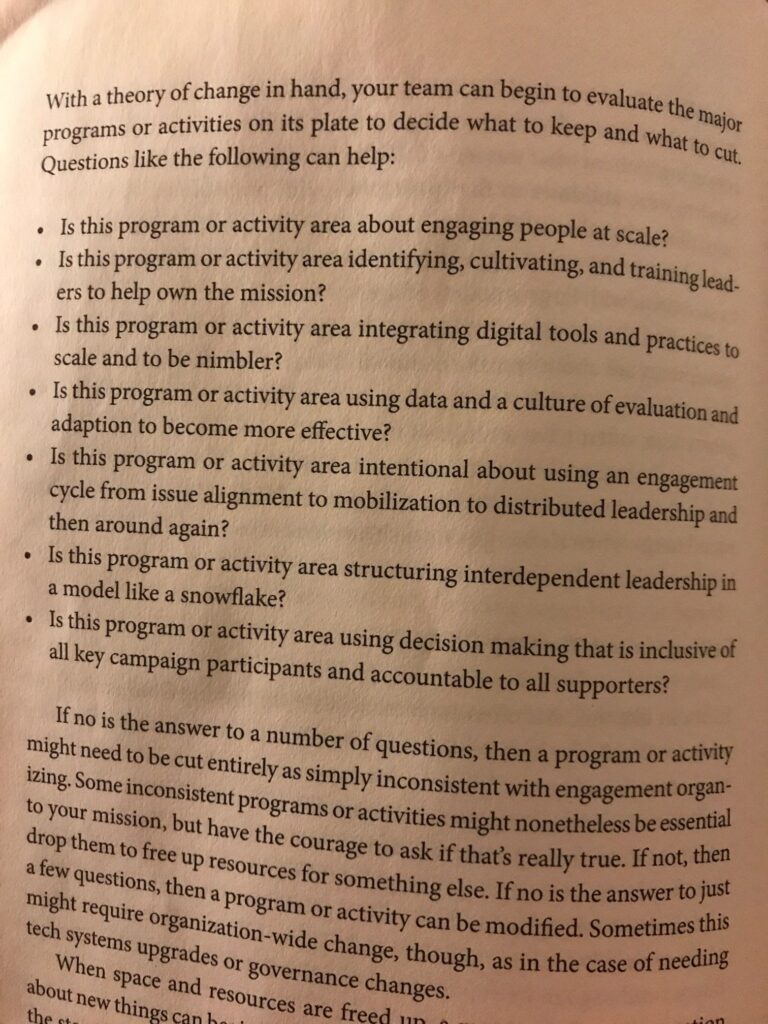
4. Overcoming organisational inertia – Linked to the work is hard, is the challenges we can face within our organisations with systems, practices, and cultures that are hard to change. Some of that comes from the experiences, practices, and expectations of those who’ve risen to more senior roles who’s campaigning was shaped in a more broadcast era (I count myself in this), some of it is about the systems we use which aren’t built, while culture is often seen as the ‘way we’ve always done things’ and is hard to shift. I’m not sure I have any simple solutions to this, but it’s something I’d like to reflect upon in future posts.
5. We need to talk about power – One of my reflections from time spent with Hahrie Han last year is that an organising approach requires us to have more conversations about power – its something that came through again reading the book. Both about how we give it away, alongside control to those we’re seeking to empower, but also how we ensure we’re directing our campaigns to focus on where the power is. As Han says ‘movements build power not by selling people products they already want but instead by transforming what people think is possible’.
I’d recommend Matt’s book for anyone interested in how to embrace a more organising approach in their campaigning.


